| Listing 1 - 10 of 13 | << page >> |
Sort by
|
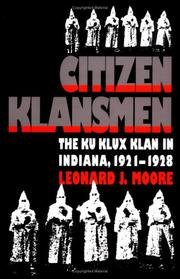
ISBN: 0807863491 9780807863497 0807819816 9780807819814 9798890868572 Year: 1991 Publisher: Chapel Hill : University of North Carolina Press,
Abstract | Keywords | Export | Availability | Bookmark
 Loading...
Loading...Choose an application
- Reference Manager
- EndNote
- RefWorks (Direct export to RefWorks)
Indiana had the largest and most politically significant state organization in the massive national Ku Klux Klan movement of the 1920s. Using a unique set of Klan membership documents, quantitative analysis, and a variety of other sources, Leonard Moore provides the first comprehensive analysis of the social characteristics and activities of the Indiana Klan membership and thereby reveals the nature of the group's political support. Challenging traditional assumptions about the Klan, Moore argues that in Indiana the organization represented an extraordinarily wide cross section of white Protestant society. More than 25 percent of native-born men in the state became official members. Indeed, the Klan was many times larger than any of the veterans' organizations that flourished in Indiana at the same time and was even larger than the Methodist church, the state's leading Protestant denomination. The Klan's enormous popularity, says Moore, cannot be explained solely by the group's appeal to nativist sentiment and its antagonism toward ethnic minorities. Rather, the Klan gained wide-spread support in large part because of its response to popular discontent with changing community relations and values, problems of Prohibition enforcement, and growing social and political domination by elites. Moreover, Moore shows that the Klan was seen as an organization that could promote traditional comunity values through social, civic, and political activities. It was, he argues, a movement primarily concerned not simply with persecuting ethnic minorities but with promoting the ability of average citizens to influence the workings of soiciety and government. Thus, Moore concludes, the Klan of the 1920s may not have been as much a backward-looking aberration as it was an important example of one of the powerful popular responses to social conditions in twentieth-century America.
Sociology & Social History --- Social Sciences --- Societies & Clubs --- Ku Klux Klan (1915- ) --- Ku Klux Klan (19th century) --- Knights of the Ku Klux Klan (1915- ) --- K.K.K. (Ku Klux Klan (1915- )) --- KKK (Ku Klux Klan (1915- )) --- K.K.K.K. (Knights of the Ku Klux Klan (1915- )) --- KKKK (Knights of the Ku Klux Klan (1915- )) --- National Knights of the Ku Klux Klan Association of America --- National Knights of the K.K.K. --- Invisible Empire --- History. --- Ku Klux Klan --- Indiana --- History
Book
ISBN: 0813161975 9780813161976 081315104X 9780813151045 0813183332 Year: 1965 Publisher: [Lexington, Kentucky] : The University Press of Kentucky,
Abstract | Keywords | Export | Availability | Bookmark
 Loading...
Loading...Choose an application
- Reference Manager
- EndNote
- RefWorks (Direct export to RefWorks)
This is a study of a disturbing phenomenon in American society -- the Ku Klux Klan -- and that eruption of nativism, racism and moral authoritarianism during the 1920's in the four states of the Southwest -- Texas, Louisiana, Oklahoma, and Arkansas -- in which the Klan became especially powerful. The hooded order is viewed here as a move by frustrated Americans, through anonymous acts of terror and violence, and later through politics), to halt a changing social order and restore familiar orthodox traditions of morality. Entering the Southwest during the post-World War I period of discontent
Ku Klux Klan (1915- ) --- Ku Klux Klan (19th century) --- Knights of the Ku Klux Klan (1915- ) --- K.K.K. (Ku Klux Klan (1915- )) --- KKK (Ku Klux Klan (1915- )) --- K.K.K.K. (Knights of the Ku Klux Klan (1915- )) --- KKKK (Knights of the Ku Klux Klan (1915- )) --- National Knights of the Ku Klux Klan Association of America --- National Knights of the K.K.K. --- Invisible Empire
Book
ISBN: 1628950706 1609171357 9781609171353 9781628960709 1628960701 9780870139956 0870139959 Year: 2011 Publisher: East Lansing : ©2011 Michigan State University Press,
Abstract | Keywords | Export | Availability | Bookmark
 Loading...
Loading...Choose an application
- Reference Manager
- EndNote
- RefWorks (Direct export to RefWorks)
In 1920s Middle America, the Ku Klux Klan gained popularity not by appealing to the fanatical fringes of society, but by attracting the interest of average citizens. During this period, the Klan recruited members through the same unexceptional channels as any other organization or club, becoming for many a respectable public presence, a vehicle for civic activism, or the source of varied social interaction. Its diverse membership included men and women of all ages, occupations, and socio-economic standings. Although surviving membership records of this clandestine organization have proved incredibly rare, Everyday Klansfolk uses newly available documents to reconstruct the life and social context of a single grassroots unit in Newaygo County, Michigan. A fascinating glimpse behind the mask of America's most notorious secret order, this absorbing study sheds light on KKK activity and membership in Newaygo County, and in Michigan at large, during the brief and remarkable peak years of its mass popular appeal.
Social conflict --- Protestants --- Middle class --- Christians --- Class conflict --- Class struggle --- Conflict, Social --- Social tensions --- Interpersonal conflict --- Social psychology --- Sociology --- Bourgeoisie --- Commons (Social order) --- Middle classes --- Social classes --- History. --- Social conditions --- Ku Klux Klan (1915- ) --- Ku Klux Klan (19th century) --- Knights of the Ku Klux Klan (1915- ) --- K.K.K. (Ku Klux Klan (1915- )) --- KKK (Ku Klux Klan (1915- )) --- K.K.K.K. (Knights of the Ku Klux Klan (1915- )) --- KKKK (Knights of the Ku Klux Klan (1915- )) --- National Knights of the Ku Klux Klan Association of America --- National Knights of the K.K.K. --- Invisible Empire --- United States --- Conflits sociaux --- History --- Histoire --- Etats-Unis --- Conditions sociales
Book
ISBN: 0268104352 9780268104351 9780268104368 0268104360 9780268104344 0268104344 9780268104344 Year: 2018 Publisher: Notre Dame, Indiana : University of Notre Dame Press,
Abstract | Keywords | Export | Availability | Bookmark
 Loading...
Loading...Choose an application
- Reference Manager
- EndNote
- RefWorks (Direct export to RefWorks)
Anti-Catholicism --- Antipapism --- Prejudices --- History --- University of Notre Dame --- Ku Klux Klan (1915- ) --- Ku Klux Klan (19th century) --- Knights of the Ku Klux Klan (1915- ) --- K.K.K. (Ku Klux Klan (1915- )) --- KKK (Ku Klux Klan (1915- )) --- K.K.K.K. (Knights of the Ku Klux Klan (1915- )) --- KKKK (Knights of the Ku Klux Klan (1915- )) --- National Knights of the Ku Klux Klan Association of America --- National Knights of the K.K.K. --- Invisible Empire --- Notre Dame, Ind. University --- South Bend (Ind.). University of Notre Dame --- South Bend (Ind.). Notre Dame University --- Notre Dame University --- Notre Dame (Ind.). University of Notre Dame --- University of Notre Dame du Lac --- Notr-Damskiĭ universitet --- History.
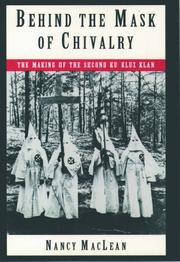
ISBN: 0199879400 0585327866 1602560625 1280451475 0198023650 9780585327860 9780195098365 0195098366 9781280451478 0195072340 9780195072341 0195098366 9786610451470 6610451478 9780203427255 0203427254 9780198023654 0197711677 9780199879403 9781602560628 Year: 2023 Publisher: New York ; Oxford University Press,
Abstract | Keywords | Export | Availability | Bookmark
 Loading...
Loading...Choose an application
- Reference Manager
- EndNote
- RefWorks (Direct export to RefWorks)
The is the story of the evolution of the Athens, Georgia, chapter of the Ku Klux Klan in the decade following World War I, when Klan influence peaked in America. It explores the interconnected social issues of race, class and sex, and how these forces combined to create such a brutal organization.
Athens (Ga.) - Race relations. --- Political Science. --- Social Science. --- Sociology & Social History --- Social Sciences --- Societies & Clubs --- #KVHA:Ku Klux Klan; Verenigde Staten --- #KVHA:Rassenstrijd; Verenigde Staten --- #KVHA:American Studies --- Political clubs --- Political societies --- Clubs --- Political parties --- Ku Klux Klan (1915- ) --- Knights of the Ku Klux Klan (1915- ) --- K.K.K. (Ku Klux Klan (1915- )) --- KKK (Ku Klux Klan (1915- )) --- K.K.K.K. (Knights of the Ku Klux Klan (1915- )) --- KKKK (Knights of the Ku Klux Klan (1915- )) --- National Knights of the Ku Klux Klan Association of America --- National Knights of the K.K.K. --- Invisible Empire --- Ku Klux Klan (19th century) --- Athens (Ga.) --- Athens-Clarke County (Ga.) --- Race relations. --- Social conditions. --- Ku Klux Klan --- Georgia --- Race relations --- Social conditions
Book
ISBN: 1283891204 161075509X 9781610755092 9781283891202 9781557289919 1557289913 Year: 2012 Publisher: Fayetteville : University of Arkansas Press,
Abstract | Keywords | Export | Availability | Bookmark
 Loading...
Loading...Choose an application
- Reference Manager
- EndNote
- RefWorks (Direct export to RefWorks)
Nazis --- Massacres --- African Americans --- Reconciliation --- Truth commissions --- Peace making --- Peacemaking --- Reconciliatory behavior --- Quarreling --- National socialists --- Fascists --- Socialists --- National socialism --- Neo-Nazis --- Atrocities --- History --- Persecution --- Afro-Americans --- Black Americans --- Colored people (United States) --- Negroes --- Africans --- Ethnology --- Blacks --- Commissions, Truth --- Reconciliation commissions --- Governmental investigations --- Human rights --- Social aspects --- Ku Klux Klan (1915- ) --- Ku Klux Klan (19th century) --- Knights of the Ku Klux Klan (1915- ) --- K.K.K. (Ku Klux Klan (1915- )) --- KKK (Ku Klux Klan (1915- )) --- K.K.K.K. (Knights of the Ku Klux Klan (1915- )) --- KKKK (Knights of the Ku Klux Klan (1915- )) --- National Knights of the Ku Klux Klan Association of America --- National Knights of the K.K.K. --- Invisible Empire --- Greensboro (N.C.) --- City of Greensboro (N.C.) --- Greensborough (N.C.) --- Race relations. --- Black people
Book
ISBN: 9780253018489 025301848X 9780253018434 0253018439 9780253018366 0253018366 0813571359 9780813571355 Year: 2015 Publisher: Bloomington
Abstract | Keywords | Export | Availability | Bookmark
 Loading...
Loading...Choose an application
- Reference Manager
- EndNote
- RefWorks (Direct export to RefWorks)
White Robes, Silver Screens highlights the ways in which the Klan used, produced, and protested against film in order to recruit members, generate publicity, and define its role within American society.
Motion pictures in propaganda --- Motion picture industry --- Moving-pictures in propaganda --- Propaganda in motion pictures --- Propaganda --- Film industry (Motion pictures) --- Moving-picture industry --- Cultural industries --- History --- Political aspects --- Ku Klux Klan (1915- ) --- Ku Klux Klan (19th century) --- Knights of the Ku Klux Klan (1915- ) --- K.K.K. (Ku Klux Klan (1915- )) --- KKK (Ku Klux Klan (1915- )) --- K.K.K.K. (Knights of the Ku Klux Klan (1915- )) --- KKKK (Knights of the Ku Klux Klan (1915- )) --- National Knights of the Ku Klux Klan Association of America --- National Knights of the K.K.K. --- Invisible Empire --- History. --- In motion pictures. --- Birth of a nation (Motion picture : 1915) --- Clansman (Motion picture : 1915) --- Birth of the nation, or, The clansman (Motion picture : 1915) --- Influence. --- Birth of a nation (Motion picture)
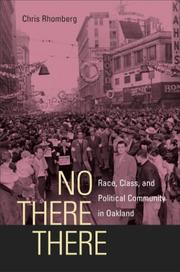
ISBN: 1282360299 9786612360299 0520940881 1597347760 9780520940888 1417525487 9781417525485 6612360291 9781597347761 0520236181 9780520236189 9781282360297 Year: 2004 Publisher: Berkeley : University of California Press,
Abstract | Keywords | Export | Availability | Bookmark
 Loading...
Loading...Choose an application
- Reference Manager
- EndNote
- RefWorks (Direct export to RefWorks)
Challenged by Ku Klux Klan action in the '20s, labor protests culminating in a general strike in the '40's, and the rise of the civil rights and black power struggles of the '60s, Oakland, California, seems to encapsulate in one city the broad and varied sweep of urban social movements in twentieth-century America. Taking Oakland as a case study of urban politics and society in the United States, Chris Rhomberg examines the city's successive episodes of popular insurgency for what they can tell us about critical discontinuities in the American experience of urban political community.
Social conflict --- General strikes --- Social classes --- Black power --- African Americans --- Class conflict --- Class struggle --- Conflict, Social --- Social tensions --- Interpersonal conflict --- Social psychology --- Sociology --- General strike --- Strikes and lockouts --- Class distinction --- Classes, Social --- Rank --- Caste --- Estates (Social orders) --- Social status --- Class consciousness --- Classism --- Social stratification --- Power, Black --- Black nationalism --- Afro-Americans --- Black Americans --- Colored people (United States) --- Negroes --- Africans --- Ethnology --- Blacks --- History --- Civil rights --- Ku Klux Klan (1915- ) --- Ku Klux Klan (19th century) --- Knights of the Ku Klux Klan (1915- ) --- K.K.K. (Ku Klux Klan (1915- )) --- KKK (Ku Klux Klan (1915- )) --- K.K.K.K. (Knights of the Ku Klux Klan (1915- )) --- KKKK (Knights of the Ku Klux Klan (1915- )) --- National Knights of the Ku Klux Klan Association of America --- National Knights of the K.K.K. --- Invisible Empire --- Oakland (Calif.) --- City of Oakland (Calif.) --- Social conditions --- Politics and government --- Race relations. --- Black people --- 20th century american culture. --- 20th century american history. --- black power struggle. --- case study. --- civil rights movement. --- class hegemony. --- class in america. --- corporate power. --- cultural studies. --- democracy. --- economic reform. --- ethnic patronage. --- general strikes. --- kkk. --- ku klux klan. --- labor protests. --- labor strikes. --- labor. --- oakland california. --- political machines. --- political. --- race in america. --- racial conflict. --- social movements. --- united states of america. --- urban political community. --- urban politics. --- urban society. --- white middle class. --- working class.
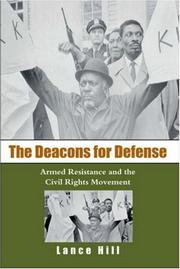
ISBN: 0807863602 9780807863602 9780807857021 9780807828472 0807828475 0807857025 9798890872098 Year: 2006 Publisher: Chapel Hill : ©2006 University of North Carolina Press,
Abstract | Keywords | Export | Availability | Bookmark
 Loading...
Loading...Choose an application
- Reference Manager
- EndNote
- RefWorks (Direct export to RefWorks)
In 1964 a small group of African American men in Jonesboro, Louisiana, defied the nonviolence policy of the mainstream civil rights movement and formed an armed self-defense organization--the Deacons for Defense and Justice--to protect movement workers from vigilante and police violence. With their largest and most famous chapter at the center of a bloody campaign in the Ku Klux Klan stronghold of Bogalusa, Louisiana, the Deacons became a popular symbol of the growing frustration with Martin Luther King Jr.'s nonviolent strategy and a rallying point for a militant working-class movement in the South.Lance Hill offers the first detailed history of the Deacons for Defense and Justice, who grew to several hundred members and twenty-one chapters in the Deep South and led some of the most successful local campaigns in the civil rights movement. In his analysis of this important yet long-overlooked organization, Hill challenges what he calls'the myth of nonviolence--the idea that a united civil rights movement achieved its goals through nonviolent direct action led by middle-class and religious leaders. In contrast, Hill constructs a compelling historical narrative of a working-class armed self-defense movement that defied the entrenched nonviolent leadership and played a crucial role in compelling the federal government to neutralize the Klan and uphold civil rights and liberties.
African American civil rights workers --- Self-defense --- Political violence --- African Americans --- Civil rights movements --- Afro-Americans --- Black Americans --- Colored people (United States) --- Negroes --- Africans --- Ethnology --- Blacks --- Violence --- Political crimes and offenses --- Terrorism --- Hand-to-hand fighting --- Martial arts --- Afro-American civil rights workers --- Civil rights workers, African American --- Civil rights workers --- History --- Political aspects --- Civil rights --- Black people --- Deacons for Defense and Justice --- Ku Klux Klan (1915- ) --- History. --- Southern States --- Louisiana --- Mississippi --- Race relations. --- Knights of the Ku Klux Klan (1915- ) --- K.K.K. (Ku Klux Klan (1915- )) --- KKK (Ku Klux Klan (1915- )) --- K.K.K.K. (Knights of the Ku Klux Klan (1915- )) --- KKKK (Knights of the Ku Klux Klan (1915- )) --- National Knights of the Ku Klux Klan Association of America --- National Knights of the K.K.K. --- Invisible Empire --- Ku Klux Klan (19th century) --- J & D Club --- Jonesboro Legal and Defense Association --- Justice and Defense Club --- Louisiana (Province) --- Louisiana (Territory) --- Louisiane --- État de Louisiane --- Léta de la Lwizyàn --- Lwizyàn --- State of Louisiana --- US-LA --- La. --- Louisianne --- Territory of Louisiana --- District of Louisiana --- Luisiana --- West Florida --- Territory of Orleans
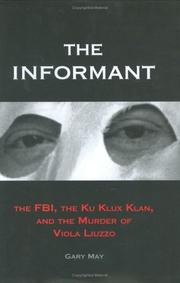
ISBN: 1281722413 9786611722418 0300129998 9780300129991 9780300106350 0300106351 Year: 2005 Publisher: New Haven ; London : Yale University Press,
Abstract | Keywords | Export | Availability | Bookmark
 Loading...
Loading...Choose an application
- Reference Manager
- EndNote
- RefWorks (Direct export to RefWorks)
In The Informant, historian Gary May reveals the untold story of the murder of civil rights worker Viola Liuzzo, shot to death by members of the violent Birmingham Ku Klux Klan at the end of Martin Luther King's historic Voting Rights March in 1965. The case drew national attention and was solved almost instantly, because one of the Klansman present during the shooting was Gary Thomas Rowe, an undercover FBI informant. At the time, Rowe's information and subsequent testimony were heralded as a triumph of law enforcement. But as Gary May reveals in this provocative and powerful book, Rowe's history of collaboration with both the Klan and the FBI was far more complex.Based on previously unexamined FBI and Justice Department Records, The Informant demonstrates that in their ongoing efforts to protect Rowe's cover, the FBI knowingly became an accessory to some of the most grotesque crimes of the Civil Rights era--including a vicious attack on the Freedom Riders and perhaps even the bombing of the Sixteenth Street Baptist Church.A tale of a renegade informant and an intelligence system ill-prepared to deal with threats from within, The Informant offers a dramatic and cautionary tale about what can happen when secret police power goes unchecked.
Murder --- Civil rights workers --- Informers --- Undercover operations --- Selma-Montgomery Rights March, 1965. --- Covert investigation (Criminal investigation) --- Covert operations (Criminal investigation) --- Operations, Undercover --- Sting operations --- Criminal investigation --- Informants (Criminal investigation) --- Police informers --- Stool pigeons --- Complaints (Criminal procedure) --- Crime prevention --- Prosecution --- State's evidence --- Civil rights activists --- Race relations reformers --- Social reformers --- Criminal homicide --- Killing (Murder) --- Homicide --- Liuzzo, Viola, --- Rowe, Gary Thomas. --- Moore, Thomas Neil --- Gregg, Viola, --- Liuzzo, Viola (Gregg) --- Ku Klux Klan (1915- ) --- United States. --- FBI --- FBR --- Federal Bureau of Investigation (U.S.) --- Federalʹnoe bi︠u︡ro rassledovaniĭ v SShA --- Knights of the Ku Klux Klan (1915- ) --- K.K.K. (Ku Klux Klan (1915- )) --- KKK (Ku Klux Klan (1915- )) --- K.K.K.K. (Knights of the Ku Klux Klan (1915- )) --- KKKK (Knights of the Ku Klux Klan (1915- )) --- National Knights of the Ku Klux Klan Association of America --- National Knights of the K.K.K. --- Invisible Empire --- Ku Klux Klan (19th century) --- Snitches (Informers) --- Persons --- Liuzzo, Viola --- Rowe, Gary Thomas --- Alabama --- Lowndes County (Ala.) --- Biography --- Ku Klux Klan --- Selma (Ala.) --- Montgomery Rights March, 1965 --- Selma to Montgomery Rights March
| Listing 1 - 10 of 13 | << page >> |
Sort by
|

 Search
Search Feedback
Feedback About UniCat
About UniCat  Help
Help News
News